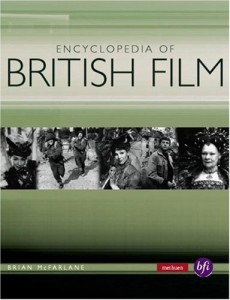The Encyclopedia of British Film edited by Brian McFarlane (Methuen in association with the British Film Institute, 2003), 774 pages, ISBN: 978-0413773012 (paperback)
N.B. This review originally appeared in issue 53 of Viewfinder. The revised 4th edition of the Encyclopedia was published in 2014 by Manchester University Press.
 About the Reviewer: Sergio Angelini is the the Head of Membership Services and Information for BUFVC and editor of its educational quarterly, Viewfinder. His print publications include contributions to: Gilbert Adair Festschrift (Verbivoracious Press, 2014); Mysteries Unlocked (McFarland, 2014); The Cult TV Book (IB Tauris 2010); Investigating Alias (IB Tauris 2007); Directors in British and Irish Cinema (BFI, 2006). For BUFVC he translated Cinema Before Cinema: The Origins of Scientific Cinematography by Virgilio Tosi (2005) and edited The Researcher’s Guide: Film, Television, Radio and Related Documentation Collections in the UK (2006).
About the Reviewer: Sergio Angelini is the the Head of Membership Services and Information for BUFVC and editor of its educational quarterly, Viewfinder. His print publications include contributions to: Gilbert Adair Festschrift (Verbivoracious Press, 2014); Mysteries Unlocked (McFarland, 2014); The Cult TV Book (IB Tauris 2010); Investigating Alias (IB Tauris 2007); Directors in British and Irish Cinema (BFI, 2006). For BUFVC he translated Cinema Before Cinema: The Origins of Scientific Cinematography by Virgilio Tosi (2005) and edited The Researcher’s Guide: Film, Television, Radio and Related Documentation Collections in the UK (2006).
Over the decades the British film industry has been first pronounced dead and then back on its feet again on so many occasions and with such regularity that one really has to question exactly on what basis the diagnosis was being made. It first flatlined officially in November 1924 when, in Simon Hartog’s words, 'All British film production stopped, and the studios went dark.' It rallied back, thanks partly to state intervention and the efforts of such entrepreneurs as Alexander Korda, and J. Arthur Rank. Fifty years later things had taken another turn for the worse, but by the early 1980s screenwriter Colin Welland when collecting his Oscar for Chariots of Fire (1981) felt confident enough to exclaim 'The British are coming!' All this and much more besides is charted in The Encyclopedia of British Film, the latest book by the indefatigable Brian McFarlane.
 The Australian film academic Brian McFarlane has for many years been demonstrating his love of British cinema with a series of excellent articles and books, ranging from his biography of the little-know B-movie director Lance Comfort to his marvellous book of interviews, An Autobiography of British Cinema (1997). His latest opus is the monumental Encyclopedia of British Film. This ambitious single volume work is clearly a labour of love and has been several years in the making. It clocks in at just under 800 pages and contains almost 6,000 individual entries as well as 100 carefully chosen stills. The sheer range of material is breath-taking, encompassing personalities, organisations, themes, trends and genres covering over 100 years of activity. There are substantial entries on such famous studios as Hammer and Ealing, but also on such less well-known ones like Walton-on-Thames and an entry on those based in the Walthamstow area. Current heartthrobs like Jason Statham appear side-by-side with character actor Paul Stassino, while writer-director Mike Figgis gets an entry as big as that devoted to his cousin, casting director Susie Figgis. Particularly welcome are general entries on such topics as Exploitation films, horror, television-to-cinema spin-offs, sex and sexuality and a single page entry on the ‘X’ certificate.
The Australian film academic Brian McFarlane has for many years been demonstrating his love of British cinema with a series of excellent articles and books, ranging from his biography of the little-know B-movie director Lance Comfort to his marvellous book of interviews, An Autobiography of British Cinema (1997). His latest opus is the monumental Encyclopedia of British Film. This ambitious single volume work is clearly a labour of love and has been several years in the making. It clocks in at just under 800 pages and contains almost 6,000 individual entries as well as 100 carefully chosen stills. The sheer range of material is breath-taking, encompassing personalities, organisations, themes, trends and genres covering over 100 years of activity. There are substantial entries on such famous studios as Hammer and Ealing, but also on such less well-known ones like Walton-on-Thames and an entry on those based in the Walthamstow area. Current heartthrobs like Jason Statham appear side-by-side with character actor Paul Stassino, while writer-director Mike Figgis gets an entry as big as that devoted to his cousin, casting director Susie Figgis. Particularly welcome are general entries on such topics as Exploitation films, horror, television-to-cinema spin-offs, sex and sexuality and a single page entry on the ‘X’ certificate.
The wealth of material here is literally the product of hundreds of people, including not only many current and ex-members of the BUFVC but also such well-respected writers and academics as Tony Aldgate, Charles Barr, Kevin Brownlow, Robert Murphy, Sarah Street and the late Raymond Durgnat.
Accompanied by a warm and typically well-informed foreword by Philip French, The Encyclopedia of British Film is an important addition to the growing books on British cinema and proves, if nothing else, that even if the industry has an uncertain future, it has had one hell of a past.
Sergio Angelini